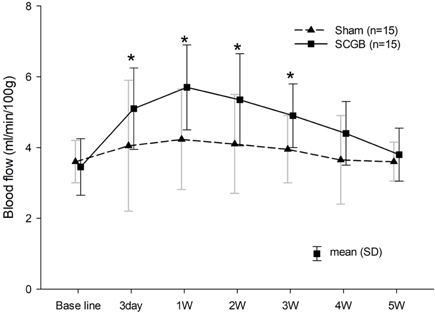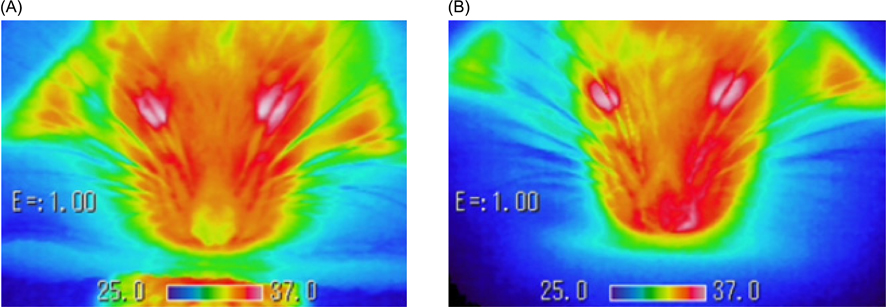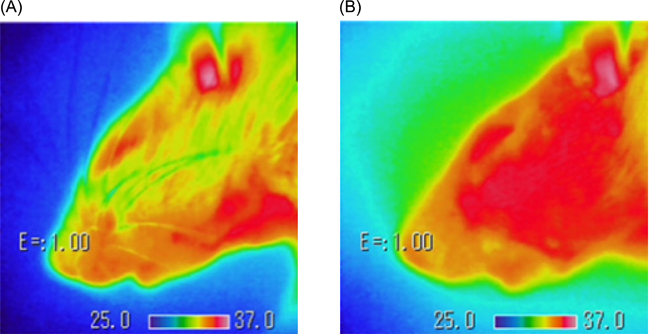J Dent Anesth Pain Med.
2018 Apr;18(2):105-110. 10.17245/jdapm.2018.18.2.105.
Changes in blood flow at the mandibular angle and Horner syndrome in a rat model of superior cervical ganglion block
- Affiliations
-
- 1Department of Dental Anesthesiology, Nippon Dental University School of Life Dentistry at Tokyo, Tokyo, Japan. katsu.sunada@nifty.com
- KMID: 2410143
- DOI: http://doi.org/10.17245/jdapm.2018.18.2.105
Abstract
- BACKGROUND
A stellate ganglion block (SGB) causes increased blood flow in the maxillofacial region, exhibiting the potential for regenerative effects in damaged tissue. The focus of this study was to understand the efficacy of SGB for regenerative effects against nerve damage. A rat model of the superior cervical ganglion block (SCGB) was created instead of SGB, and facial blood flow, as well as sympathetic nervous system function, were measured.
METHODS
A vertical incision was made on the left side of the neck of a Wistar rat, and a 5-mm resection of the superior cervical ganglion was performed at the back of the bifurcation of the internal and external branches of the left common carotid artery. Blood flow in the skin at the mandibular angle and mean facial temperature were measured using a laser-Doppler blood flow meter and a thermographic camera, respectively, over a 5-week period after the block. In addition, the degree of ptosis and miosis were assessed over a period of 6 months.
RESULTS
The SCGB rat showed significantly higher blood flow at the mandibular angle on the block side (P < 0.05) for 3 weeks, and significantly higher skin temperature (P < 0.05) for 1 week after the block. In the SCGB rat, ptosis and miosis occurred immediately after the block, and persisted even 6 months later.
CONCLUSIONS
SCGB in rats can cause an increase in the blood flow that persists over 3 weeks.
MeSH Terms
Figure
Reference
-
1. Salvaggio I, Adducci E, Dell'Aquila L, Rinaldi S, Marini M, Zappia L, et al. Facial pain: a possible therapy with stellate ganglion block. Pain Med. 2008; 9:958–962.
Article2. Milligan NS, Nash TP. Treatment of post-herpetic neuralgia. a review of 77 consecutive cases. Pain. 1985; 23:381–386.
Article3. Melis M, Zawawi K, al-Badawi E, Lobo S, Mehta N. Complex regional pain syndrome in the head and neck: a review of the literature. J Orofac Pain. 2002; 16:93–104.4. Lynch ME, Elgeneidy AK. The role of sympathetic activity in neuropathic orofacial pain. J Orofac Pain. 1996; 10:297–305.5. Kohjitani A, Miyawaki T, Kasuya K, Shimada M. Sympathetic activity-mediated neuropathic facial pain following simple tooth extraction: a case report. Cranio. 2002; 20:135–138.
Article6. Shionoya Y, Sunada K, Shigeno K, Nakada A, Honda M, Nakamura T. Can nerve regeneration on an artificial nerve conduit be enhanced by ethanol-induced cervical sympathetic ganglion block? PLoS One. 2017; 12:e0189297.
Article7. Tsujimoto G, Sunada K, Nakamura T. Effect of cervical sympathetic ganglionectomy on facial nerve reconstruction using polyglycolic acid-collagen tubes. Brain Res. 2017; 1669:79–88.
Article8. de la Torre JC, Goldsmith HS. Increased blood flow enhances axon regeneration after spinal transection. Neurosci Lett. 1988; 94:269–273.
Article9. Haapaniemi T, Nylander G, Kanje M, Dahlin L. Hyperbaric oxygen treatment enhances regeneration of the rat sciatic nerve. Exp Neurol. 1998; 149:433–438.
Article10. Kakuyama M, Toda H, Osawa M, Fukuda K. The bilateral effect of stellate ganglion block on the facial skin blood flow. Reg Anesth Pain Med. 2000; 25:389–392.
Article11. Winnie AP, Ramamurthy S, Durrani Z, Radonjic R, Shaker MH. Pharmacologic reversal of Horner's syndrome following stellate ganglion block. Anesthesiology. 1974; 41:615–617.
Article
- Full Text Links
- Actions
-
Cited
- CITED
-
- Close
- Share
- Similar articles
-
- Bilateral Horner's Syndrome after a Stellate Ganglion Block
- Prolonged Horner's Syndrome following Stellate Ganglion Block: A case report
- Prolonged Horner's Syndrome Following Stellate Ganglion Block
- Contralateral Horner's Syndrme after Stellate Ganglion Block: A case report
- Flow Velocity Changes of Carotid, Axillary, Brachial and Radial Artery after Stellate Ganglion Block







